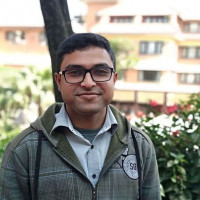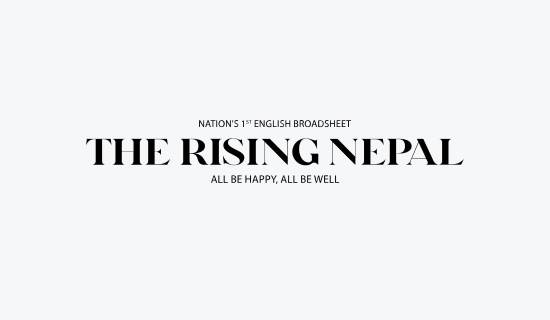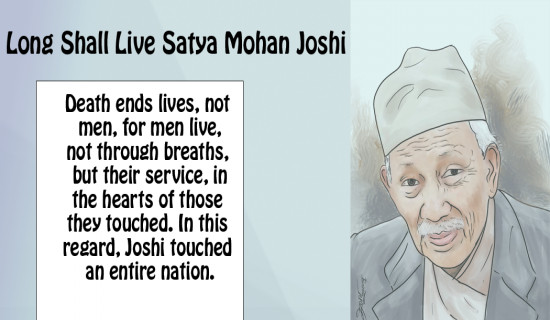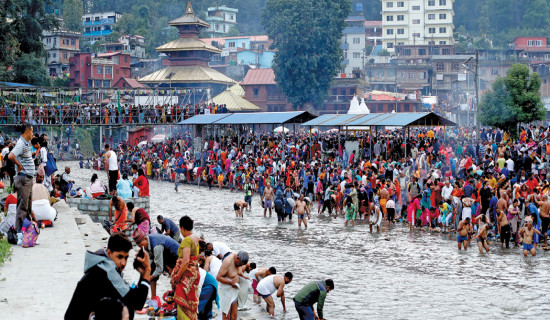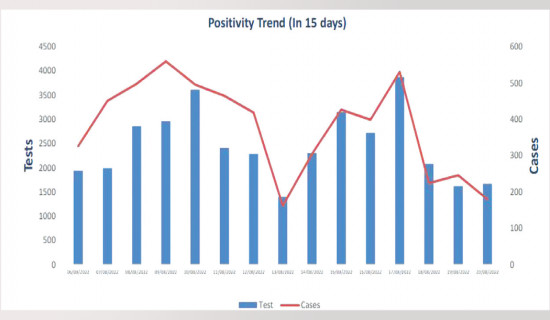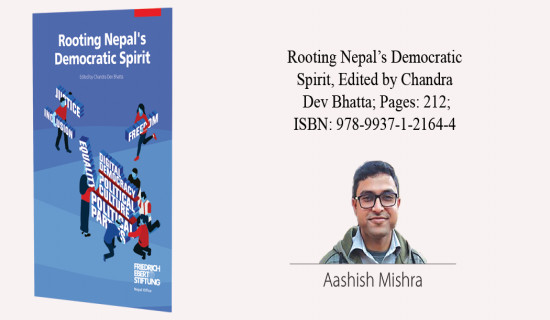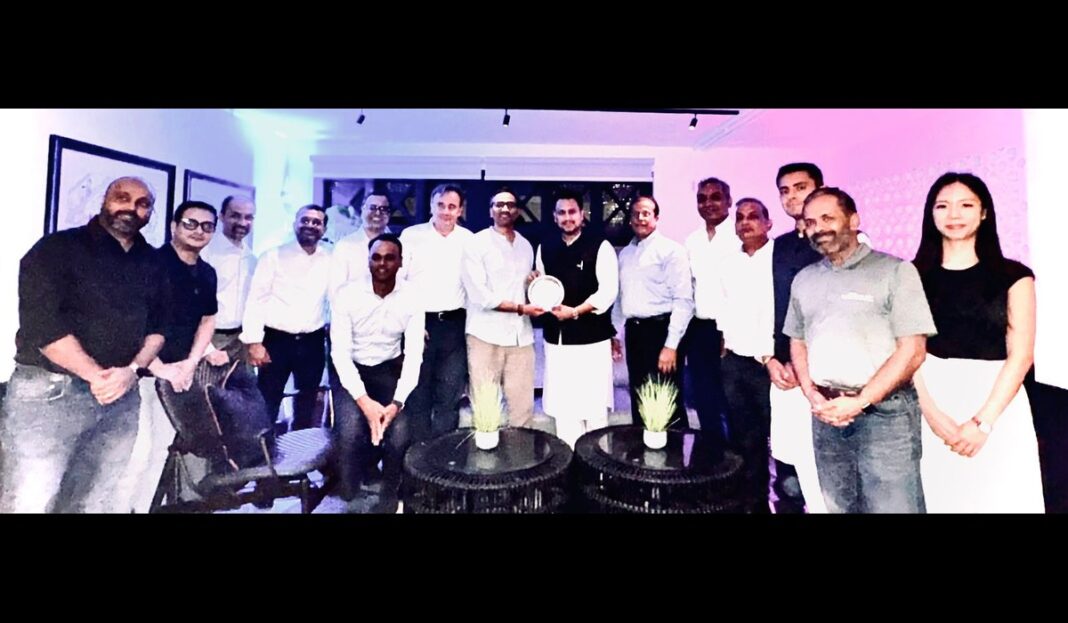- Friday, 24 October 2025
Chhath: Worshipping the goddess who brought dead child back to life
Priyavrata, the son of Swayambhu Manu (the first ruler of the Earth) and the spiritual grandson of Brahma, was a pious man with little interest in worldly affairs. He desired to devote his life to meditation and service and wanted to remain a bachelor for eternity. Unfortunately, this clashed with the wishes of his family and he was forced to marry a woman who would be known to the world as Malini. Perhaps because of this coerced nature of their relationship, the couple could not conceive. So, on the advice of the gre
Jumbled Tithis upset Tihar calendar this year
Yamapanchak began this year on Saturday with Dhanteras. As the ‘Panchak’ in its name suggests, the festival, better known as Tihar, is generally celebrated for five days from the 13th day of the dark fortnight of the Nepali month of Kartik to the second day of the bright fortnight. However, this Bikram year of 2079 has given Nepalis a confusing six-day Deepawali, one where Kukur Tihar and Laxmi Puja have fallen on the same day but Laxmi Puja and Gai Puja have uncharacteristically not.
Spend Responsibly
Festivals are expensive and seem to be getting more expensive by the year. Occasions that used to need only a few thousand rupees now cost a lot more and celebrations are gradually becoming unaffordable for the middle class. Much of it is because of inflation and the rising cost of goods but some of it is also because of our own extravagant spending habits. We forget the adage ‘Cut your coat according to your cloth’ during festival times and tend to spend during religious festivals like Dashain and Tihar and social festivals like weddings and birthdays.
Nepali ancestry traced to South and East Asia
Most Nepalis have derived their maternal ancestry from South and East Asia, an international team of researchers have found. As per the team, led by Dr. Kumarasamy Thagaraj of India’s Council of Scientific and Industrial Research (CSIR)-Centre for Cellular and Molecular Biology (CCMB) and Dr. Tilak Ram Shrestha of Nepal’s Tribhuvan University (TU), an analysis of the mitochondrial DNA of Nepal’s various ethnic groups revealed South and East Asian lineages. The team analysed the DNA sequence of 999 individuals belonging to different communities of the country, including Newa, Magar, Sherpa, Brahmin, Tharu and Tamang, living in Kathmandu and eastern Nepal and published their findings on Saturday in the journal Human Genetics.
Leaving Behind Lasting Legacy
The only sure thing about life is that it ends. Death is the cruel inevitability that no one, rich or poor, loved or hated, big or small, can dodge. So perhaps we should have been more prepared for the passing of the great Satya Mohan Joshi at 7.09 am on October 16.
Why Do We Sneeze?
Ah-Ugh-Oo. 4 am Friday and this scribe is awoken by a strange short shriek. Ah-Ugh-Oo!
Enabling students to express through stories
Katha Bunaun. Let’s weave stories.An initiative by the organisation Canopy Nepal, Katha Bunaun is a week-long programme that works with schools to help enhance young learners’ skills in story writing and telling. It is designed to assist young learners in embodying their imagination and has been crafted by Canopy in line with its larger goal of providing underprivileged childre
Dashain: Tranquil, festive and drenched this year
Dashain is traditionally viewed across Nepal as an occasion for relaxation and celebration. Even if they do not observe the festival religiously, people use it to take a break from work and seek the comfort of family. That is why many who live and toil in Kathmandu year-round leave the capital on Dashain and return to the cities and villages where their parents and relatives reside.
Generation Gap
Generation gap – a gap that defines the difference in experiences, beliefs and opinions of people born at different times under different social standards – is a concept that has been accepted and understood for a long time. Everyone accepts that the world their children live in is not the same that they inhabited while growing up. Parents and grandparents know that they cannot relate to the youths of today and the youths are also fully aware that their knowledge may become obsolete by the time they have kids of their own. However, while it previo
Father's Day marked with fervour, reverence
Saturday was Father’s Day in Nepal and people across the country marked it with love and devotion. As a sign of respect towards their fathers, children gave them sweets and food items and dedicated posts of adoration and gratitude on social media. Those whose fathers have passed away visited Gokarna in Kathmandu, Betravati in Rasuwa and Bishnupaduka in Sunsari and prayed for the eternal peace of their deceased pater’s soul. Father’s Day, or Buba ko Mukh Herne Din (The day to see father’s face), is an important occasion in the Nepali calendar, one that holds additional significance for people who do not get to share this day with their dads in person; people like 23-year-old Pushpika Nakarmi. Her father is currently in Austria to visit her brother and sister-in-law.
Amid rising COVID cases, people still continue avoiding precautions
Over the last week, Nepal detected an average of 639 new cases of COVID-19 every day. The positivity rate hovered around 12.5 per cent and fatality stood at around 1.2 per cent. The Ministry of Health and Population (MoHP) has placed Kathmandu and Lalitpur in the red zone, meaning they both have more than 500 active cases of the coronavirus each. Beyond the valley, the number of people admitted to hospitals for the disease has crossed 150, those in the Intensive Care Units (ICUs) is over 40 and the count of people requiring ventilators is also steadily rising.
Preserve Intangible Cultural Heritage
We may have heard people say that Nepal’s intangible culture is the backbone of its civilisation and that its tangible heritage stands on the foundations built by its intangible heritage. Thanks to its use by organisations like the United Nations Educational, Scientific and Cultural Organisation (UNESCO), intangible cultural heritage has gained a lot of currency in scholarly circles in recent decades. But what exactly is intangible cultural heritage?
Time To Be Careful Again
Here is an unfortunate truth: COVID-19 is back! With new daily cases dropping to single digits, deaths becoming zero, and staying zero for months, and vaccination numbers rising, it seemed like we had finally defeated the coronavirus for good. But apparently, we were wrong. So, what does this mean? Well, for starters, it means that we might see a fourth wave of the pandemic in the country. And second, it means that we have to adopt precautions, such as masking up and avoiding large gatherings, again.
An Analysis Of Democracy
Democracy is not a prerogative of any one country, region, or population. Rather, it is an ideal based on the common values of justice, inclusion, equality, and freedom. Democracy is not perfect; it is a work-in-progress that requires diligent effort from all sectors of society to be successful.
So many monuments, so little information
Kathmandu, July 21: The first monument one sees on their left when entering the Patan Durbar Square from the main road is the octagonal stone Shikhar temple Chyasing Dega. Built by Princess Yogamati in 1723, the temple holds the rather uncomfortable distinction of being dedicated to the memory of King Yoganarendra Malla, Yogamati’s father, and his 31 (some say 32 or 35) queens and concubines who performed Sati after his death.Opposite to the temple flanking the entrance to the Sundari Chowk are the statues of Ganesh, Narsingh and Hanuman, specifically placed in that order to spell out Siddhi (Ganesh) Narsingh Malla (Hanuman).Across the brick-paved street from Patan Museum behind the stage where Kartik Naach is performed is the Char Narayan Temple which is the oldest temple in the entire Patan complex. But you would not know any of this by reading the brochure Lalitpur Metropolitan City has prepared for tourists or even by visiting the Durbar Square yourself. “Every building here [at Patan Durbar Square] carries such fascinating history. Unfortunately, we do not share it with the national and international visitors that come here,” lamented local Damodar Pradhan. An example of this is the Patan Museum. The over 400 people that visit this facility every day get to learn a lot about the artefacts on display from their information cards and the museum staff. However, they do not get to know that the Keshav Narayan Temple behind Patan’s iconic golden door is one of the eight ‘Manis’ (pearls) of the Durbar Square that give it its name Manigal (Mangal/Mangalbazaar). There are no cards describing the story of the magical queen who could walk on water at the Bhandarkhal Pond and people do not get to know that the Sundari Chowk courtyard was once the site of a Buddhist monastery that is today at Haka Bahal, Lalitpur, as mentioned in the book ‘Nepālikabhūpavaṃśāvalī: (History of the kings of Nepal), a Buddhist chronicle’ and recorded by the Nepal Heritage Documentation Project. Visitors are also deprived of the information that the museum’s emblematic golden window could actually be an addition made during the Shah period rather than something installed during the construction of the palace in the Malla era, as per Dr. Gudrun Buhnemann of the University of Wisconsin-Madison’s 2012 article ‘Śiva and Avalokiteśvara: On the iconography and date of the Golden Window and Golden Door of Patan's Royal Palace.’“Often the story of our museum building and its surrounding structures is more interesting than the objects housed in them,” said Pradhan.Suresh Man Lakhe, acting executive director, told The Rising Nepal that Patan Museum did offer free guided tours to those who requested them. Additionally, its brochure serves to introduce those who read it to some key historic sites inside Lalitpur’s core city; namely, Kumbeshwor, Golden Temple, Kumari House, Mahaboudha and Okubahal. But this is not enough to cover the vast scope of the ancient town, complained tour guide Utsav Shakya.The condition is same at Hanumandhoka Durbar Museum whose brochure, while presenting photos of areas inaccessible to the ticket-buyers, does not even list the names of all its 12 courtyards, let alone their related monuments. The around 1,000 people who visit this museum based in the palace used by arguably the two most consequential dynasties in Nepali history – Malla and Shah – get to enter the Nasal Chowk, Lohan Chowk, Putali Garden and the ornaments gallery but often overlook the raised platform used by the Shah kings for their coronation in the first yard, step over the stone that gives the second yard its name, do not realise that the snakehead in the pond in the third garden is stolen from Bhaktapur and that the fourth gallery was once used as a storehouse.To mitigate this, Hanumandhoka also plans to have guided tours twice a week, informed Executive Director Sandeep Khanal. He shared that the museum used to offer such tours before the COVID-19 pandemic and was seeking to resume them.However, guide Shakya was sceptical and felt that many would not know about it or choose not to take it. “Travellers who do not want a guide or seek to approach the authorities must also get to know our cities’ history, culture, civilisation and significance,” he said.Posters and signboards in front of the temples and buildings could be a way to do that but they risk desecrating them. “We must keep in mind that they are also places of active worship or are integral parts of the communities they are located in in other ways,” Rishi Amatya, heritage interpretation practitioner cautioned. In heritage interpretation, Amatya has spent many years studying and applying ways to convey the meaning of monuments to people who do not understand or necessarily have an interest in understanding them. “We have to make our heritage relatable and immersive,” he said.And a good way to do that would be through self-guided interactive maps, Amatya felt. These maps steer individuals around historic sites and give them important facts about the things they encounter along the way. They can also be dramatised with characters to make them interesting. Amatya, in collaboration with artist Suman Maharjan and art educator Sharareh Bajracharya, has previously prepared and provided Patan and Hanumandhoka museums with interactive maps of their respective areas. These maps, he shared, are primarily targeted to students and children.However, except for maps, could QR codes serve the same purpose? “No,” Amatya suggested, as not everyone may have a smartphone or internet access when at heritage spots. “They also keep people engaged with their phones more than the monument.”But something needs to be done and done soon, urged Shakya. “Because the lack of readily available information is preventing both visitors and locals from grasping the whole scope and context of our cultural heritage,” he worried.

